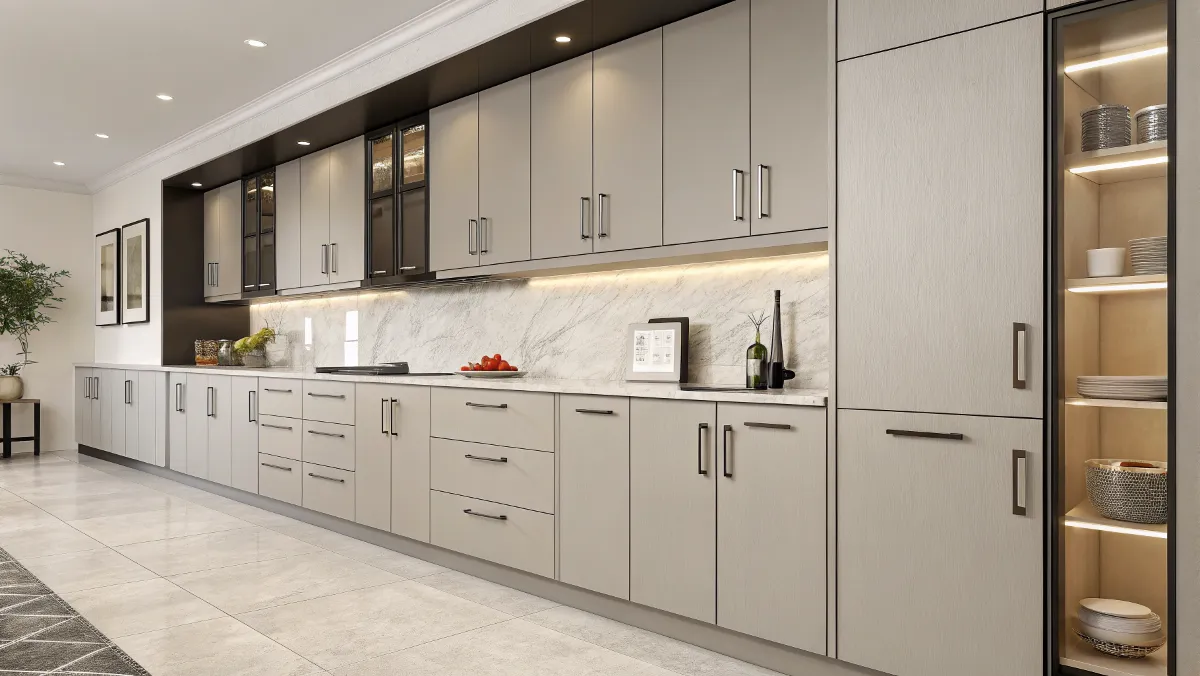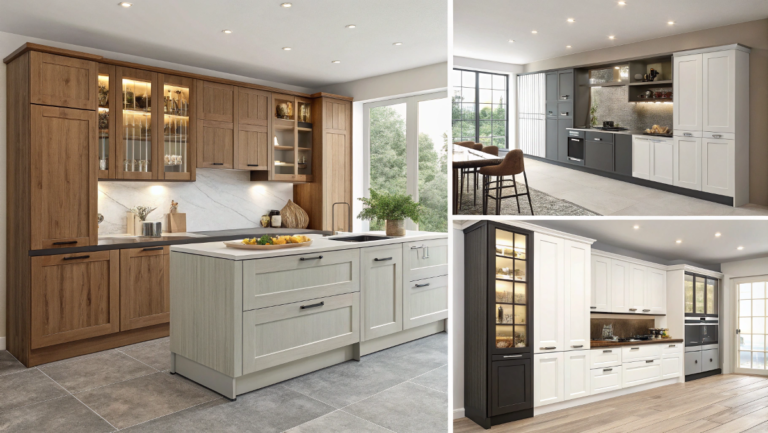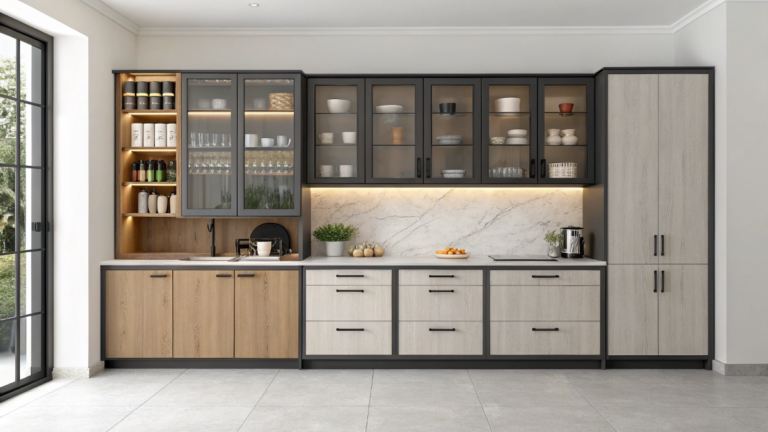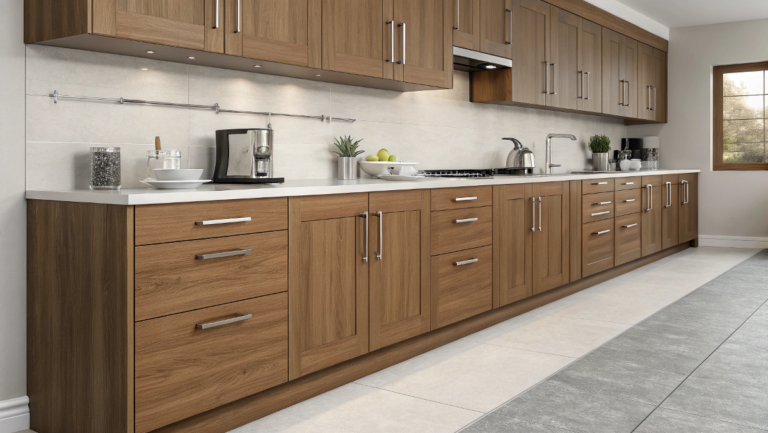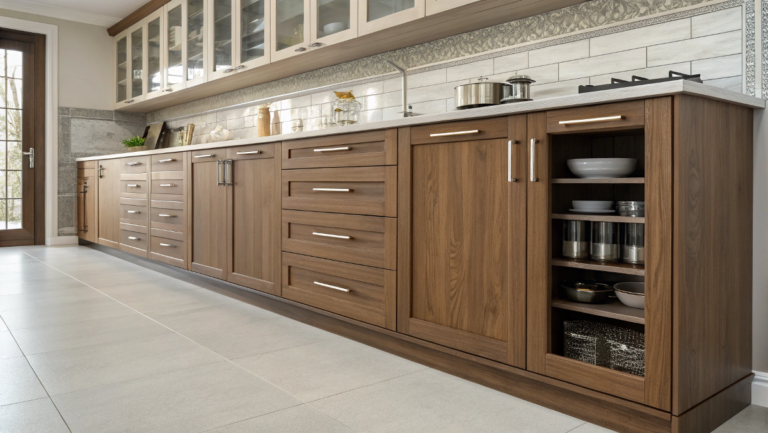Cabinet Materials I’ve Tried and Loved or Regretted
It was one of those rainy Saturday mornings, the kind where you convince yourself you’re finally going to tackle that kitchen cabinet project you’ve been putting off for three months. I had a cup of lukewarm coffee in one hand and a sanding block in the other (because, of course, I’d lost my electric sander again), staring down a pair of chipped, yellowing cabinet doors from 1982. And let me tell you: I had no idea what I was doing.
Here’s the thing: when you’re starting, all cabinet materials kinda look the same. Wood is wood, right? (Wrong. So wrong.) I learned that after painting over particleboard, thinking it was solid oak… and watching it bubble and peel within a month. That was my first real lesson: not all cabinet materials are created equal. Some are sturdy and forgiving. Others? Let’s just say they don’t love heat, humidity, or curious toddlers with peanut butter fingers.
If you’re staring at your cabinets wondering, “What is this made of, and does it even matter?”, I’ve got you. I’ve worked with most of the common cabinet materials out there, some on purpose, some by accident, and I’m here to tell you the truth. No jargon. No contractor-speak. Just real-life experience, budget blunders, and a few sweet wins.
Let’s break down the most common types of cabinet materials, what they’re actually like to live with, and which ones are worth your time (and which ones I wouldn’t touch again with a 10-foot level).
Cabinet materials include solid wood, plywood, MDF, particleboard, laminate, thermofoil, veneer, melamine, and acrylic. Solid wood and plywood offer durability and long-term value, while MDF and laminate provide budget-friendly, smooth finishes ideal for painting. Particleboard is the least durable but cheapest option. The best cabinet material depends on your needs: solid wood for luxury, plywood for strength, and MDF or laminate for affordable style.
Solid Wood Cabinets, The Classics That Make You Feel Fancy
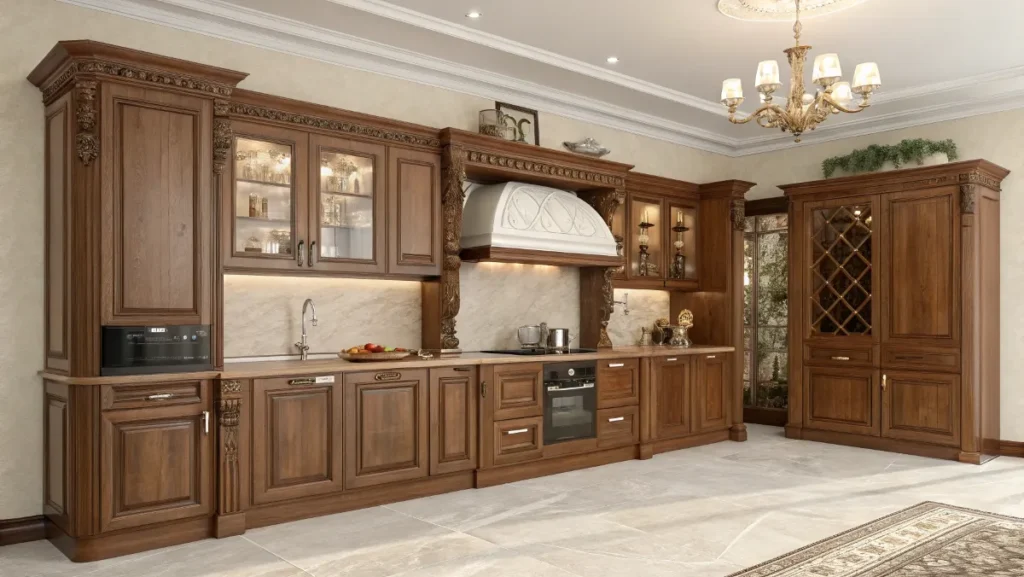
I remember the first time I touched real oak cabinets. I was helping my neighbor Linda install new handles in her kitchen. Well, I was mostly offering moral support and snacks, and I ran my hand over the door and said, “Wait, this is actual wood?” She laughed and told me they were cherry, not oak (still can’t tell the difference, to be honest). But that moment stuck. Solid wood just feels different, like the kind of kitchen you grow into, not live in.
But here’s the thing they don’t always tell you: solid wood is picky. It’s like that friend who looks amazing in every photo but gets cranky in the rain. We used maple for our lower cabinets when we first renovated, and while they held up like champs for the most part, I noticed the center panels started bowing slightly after our first humid summer. (Note to self: install that dehumidifier before the heatwave hits.)
Why People Love It
-
It’s undeniably beautiful, with grains, knots, and all.
-
Ages gracefully (like wine or old denim).
-
You can sand, stain, or paint it multiple times.
-
If scratched? A quick touch-up usually does the trick.
But Real Talk…
-
It’s expensive; our maple doors alone were half the cabinet budget.
-
Not humidity-proof (ask me about the weird swelling pattern that looked like a ghost face).
-
Needs occasional love, polishing, wiping, and a little babying.
If you’re someone who loves the idea of cabinets that tell a story, like, “These were here before we had kids,” or “We changed the stain after that salsa explosion, then solid wood is your friend. Just be prepared for some mood swings when the seasons shift.
Can I tell if my cabinets are real wood?
Yes, sort of. Check the back of the doors or inside the frames. Real wood has natural grain and may show tiny imperfections. Engineered wood usually looks too smooth or uniform. You can also lightly knock; it should sound solid, not hollow.
Plywood Surprisingly Strong, and Forgiving for DIYers
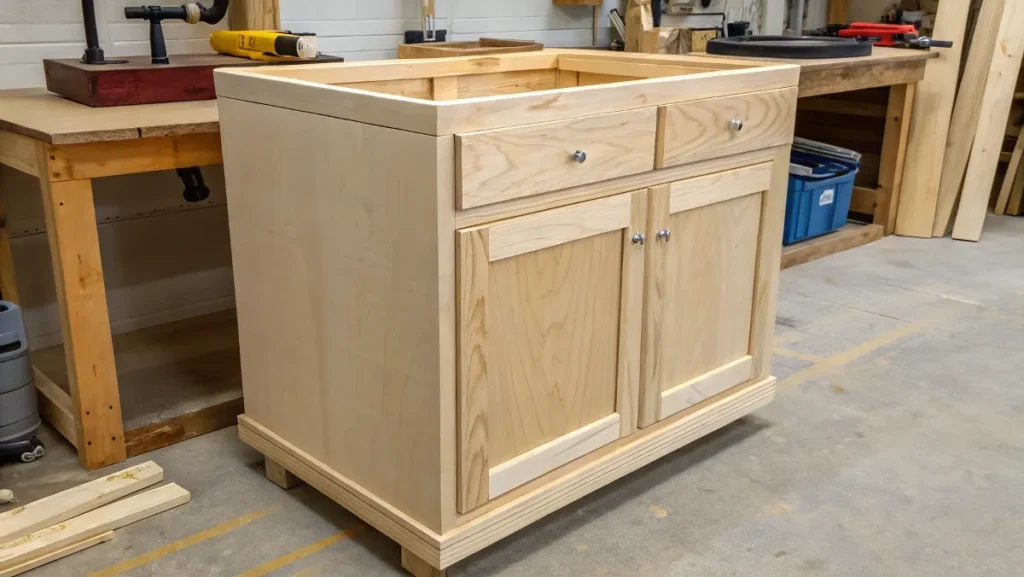
Okay, confession time: I used to think plywood was just cheap filler stuff for floors or garage shelves. You know, the kind of thing you hide behind paint or shove in the shed. But then I built my own under-sink cabinet boxes (after watching six YouTube tutorials and ignoring four of them), and plywood turned out to be the real MVP.
Here’s what surprised me: it’s tough. Like, seriously tough. That cabinet has survived three years, two toddler water floods, and one very ambitious under-sink compost bin experiment. It might not have the natural glamour of cherry wood or walnut, but for everyday kitchen chaos? It holds its own.
Why I’m Team Plywood Most of the Time
-
It’s strong, especially when you’re dealing with wide cabinet boxes.
-
It doesn’t freak out when the humidity spikes.
-
It plays well with others, paint, veneer, even contact paper if you’re feeling wild.
-
It’s less likely to warp than solid wood (which I learned the hard way).
But Also…
-
It still needs a finish; raw plywood isn’t exactly dreamy to look at.
-
The edges can chip or fray, especially if you’re cutting without proper tools been there.
-
Quality varies a lot; some sheets are sturdy, others peel like bad sunburn.
I usually pair plywood boxes with nicer doors, either solid wood or MDF, because it lets me save on structure without sacrificing the look. It’s one of those materials that doesn’t ask for much but shows up strong. (Unlike my drill, which died halfway through installation.)
Is plywood better than MDF?
Depends on what you’re doing. For cabinet boxes that need to handle weight or moisture? Plywood wins. For doors that need smooth painting? MDF might be your bestie. I mix and match, like a weird cabinet DJ.
MDF & Particleboard AKA What My First Kitchen Was Made Of
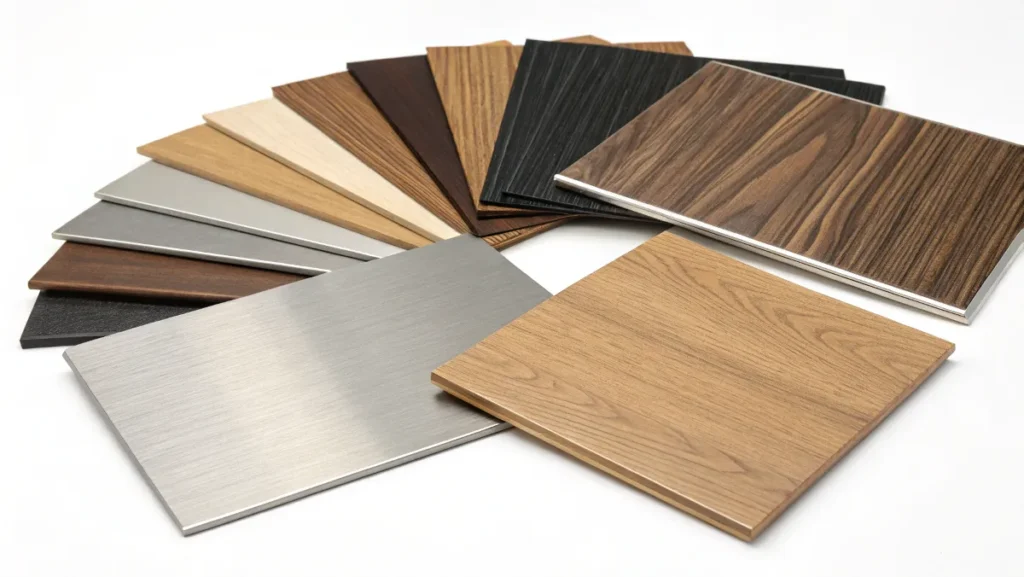
My first kitchen renovation was… optimistic. I was convinced I could redo everything myself on a $600 budget and sheer enthusiasm. That led me straight to the big box store aisle labeled “pre-fab magic,” which is how I ended up with cabinets made of MDF and particleboard. They looked great. For about 10 minutes.
Let’s start with MDF (Medium Density Fiberboard). It’s like the overachiever of the engineered wood world, smooth, uniform, and amazing for painting. I used it for some upper cabinet doors, and honestly? They looked custom once painted. Until the edges started swelling from a rogue steam puff from the rice cooker. Lesson learned: MDF does not appreciate moisture.
Now particleboard? That’s MDF’s sloppier cousin. I had a pantry made from the stuff. One day, a bottle of olive oil tipped over inside it, and two weeks later, the shelf looked like a raccoon had chewed it. It hadn’t, but the swelling was just that bad.
Here’s What I Still Like About Them
-
MDF paints like a dream, no grain, no weird texture.
-
Super budget-friendly, I’m talking under $30 for some panels.
-
Great for upper cabinets or spots that don’t see a lot of abuse.
What Drives Me Nuts
-
Both can swell with just a little water exposure, like one steamy night of cooking.
-
Particleboard crumbles if you sneeze on it.
-
You can’t repair damage; once it bubbles or chips, it’s game over.
If you’re doing a fast flip, outfitting a rental, or just want a clean, painted look without spending much, MDF might be your friend. But keep particleboard far from anything remotely damp. (Also, maybe just keep your olive oil somewhere else.)
Can I paint over particleboard or MDF?
Yes, but prep is key. Sand lightly, prime with something like Zinsser BIN (learned that one after my first primer peeled off in sheets), and use a paint with a built-in sealer. Don’t skip the edges, they’re the first to swell.
Laminate & Thermofoil Budget-Friendly but Heat Drama Queens
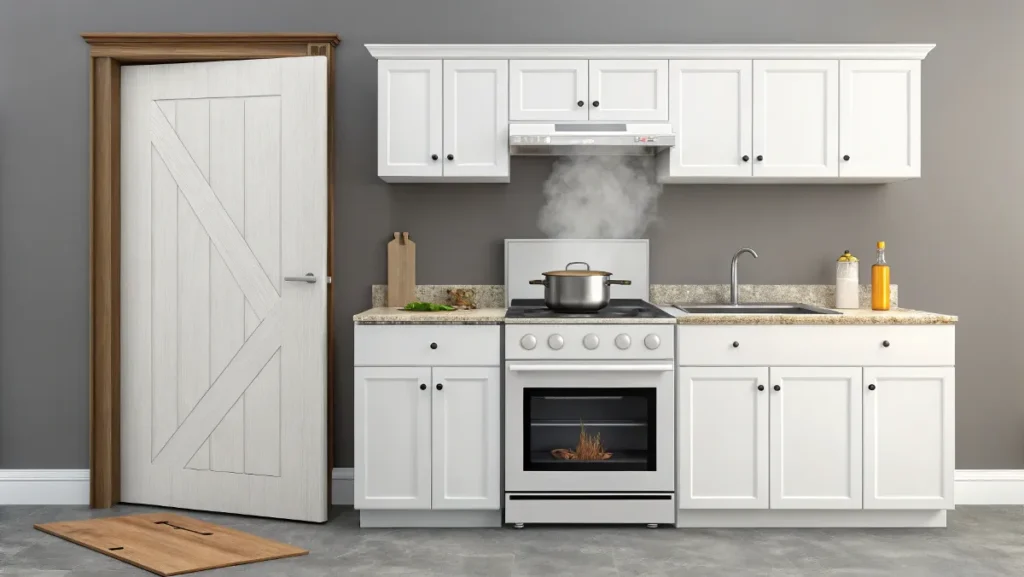 So here’s what happened: I installed these crisp white thermofoil cabinet doors in our small side kitchenette (because they were on sale and honestly, they looked great). Three weeks later, I made pasta. Like, one pot of boiling water near the stove. And boom, one of the doors closest to the burner started puckering like a microwaved marshmallow.
So here’s what happened: I installed these crisp white thermofoil cabinet doors in our small side kitchenette (because they were on sale and honestly, they looked great). Three weeks later, I made pasta. Like, one pot of boiling water near the stove. And boom, one of the doors closest to the burner started puckering like a microwaved marshmallow.
That was the day I learned that thermofoil and heat are not friends.
Laminate and thermofoil are often lumped together, and while they both offer sleek, affordable finishes, they have different personalities. Laminate is like that dependable friend who wears the same outfit every day but somehow never stains it. Thermofoil? More like the stylish friend who always looks amazing but melts under pressure (literally).
Why You Might Love Them
-
Super affordable, I got my thermofoil doors for around $28 each.
-
Easy to clean, one swipe with a cloth and done.
-
Modern, glossy finishes without the custom price tag.
-
Great for low-traffic or non-cook zones (think laundry room or mudroom storage).
But They’ve Got Baggage
-
Thermofoil is heat-sensitive,
-
It can delaminate or blister near ovens or cooktops.
-
Laminate edges can chip if bumped just right (or wrong).
-
Neither can be refinished; once damaged, replacement is usually your only option.
I still like using laminate for cabinets that don’t deal with heat. Our laundry room has some high-gloss gray ones that have held up beautifully. But in a kitchen that sees serious cooking? I’d think twice before going full thermofoil again. (Unless I install it far, far from the stove, and maybe the toaster.)
Can I repair bubbling thermofoil?
Technically? Sometimes. You can try using contact cement or heat-activated glue to re-adhere the vinyl. But honestly? It’s tricky, and the finish may never look quite right again. I just replaced mine and called it a lesson.
Veneer Looks Fancy but Requires TLC
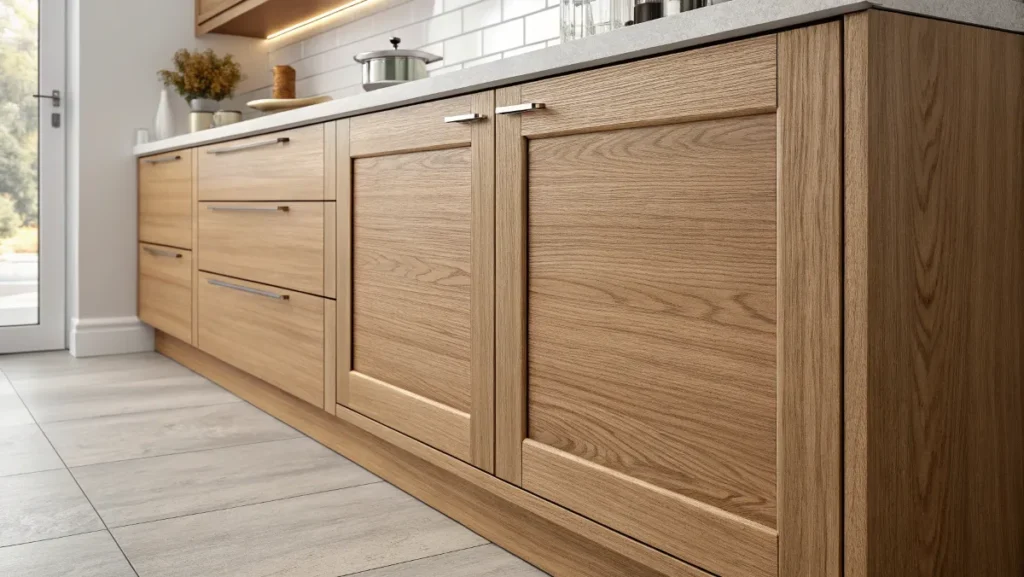
Let me tell you about the time my dog’s tail took out a veneer cabinet panel. We were dog-sitting for my sister, and her overly enthusiastic golden retriever whipped around, knocked over a broom, and the broom handle caught the bottom edge of the cabinet. The thin layer of veneer peeled back like a sad little sticker. I stood there holding the broom like it was a crime weapon.
That’s when I realized veneer might look like the real thing, but it’s definitely not as tough.
Veneer is basically a thin slice of real wood glued onto a base (usually plywood or MDF). It gives you that gorgeous woodgrain look without the full cost of solid hardwood. And when it’s done well? It’s stunning. But it also needs a little extra love.
Why Veneer Can Be Great
-
You get the high-end wood look without the solid wood price tag.
-
It’s lightweight, which makes installation easier (especially solo).
-
Easy to clean and comes in a bunch of wood species and finishes.
-
Perfect for a “designer kitchen” look on a realistic budget.
But Watch Your Step
-
It’s fragile; its edges and corners can peel or chip if bumped.
-
Water is not its friend (I had a spill near the sink that lifted the edge like a page).
-
Repairs can be fiddly and not always seamless.
That said, I still use veneer when I want to “fake fancy” without blowing the budget. I just keep it out of the splash zone—no sinks, no dishwashers, no high-traffic corners where the kids race their scooters (don’t ask). It’s best for upper cabinets, appliance garages, or spots that are more for show than for daily kitchen battles.
Can I glue veneer back down if it lifts?
Yes, if you catch it early. Use wood glue and clamp it down overnight. I used painter’s tape and a heavy cookbook once. It kinda worked… until my toddler pulled the tape off the next morning. Moral: Clamp if you can.
Melamine, Acrylic, & Other “Modern” Materials (Mixed Bag)
I remember walking into a showroom and seeing these sleek, glossy, handleless cabinets that looked like they belonged in a futuristic cooking lab. I was smitten. The sales guy told me they were acrylic-faced with a melamine core, and I nodded like I understood what that meant. (Spoiler: I didn’t.)
A week later, I ordered two “modern” cabinet fronts for our utility nook. When they arrived, one had a warped corner, and the other weighed as much as my toddler. That’s when I started digging into what these materials are, and how they hold up in real life.
Melamine & Acrylic, Explained the Non-Techy Way
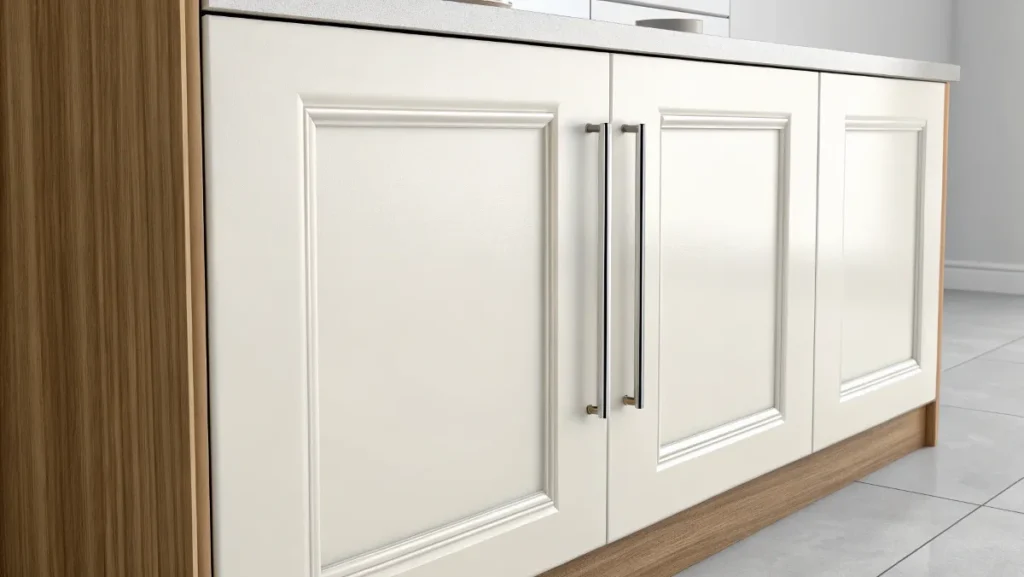
-
Melamine is a type of plastic coating pressed onto a base (like MDF or particleboard). It’s usually matte or satin.
-
Acrylic is that super-glossy, mirror-like finish you see in modern kitchens. It’s smooth, bold, and reflects light like a champ.
Why You Might Be Tempted
-
Slick, high-end appearance, especially with acrylic.
-
Moisture-resistant and pretty easy to clean.
-
Tons of color options, from bold red to soft foggy grey.
-
Budget versions of these can look fancy without the fancy cost.
But Let Me Be Honest…
-
Acrylic scratches so easily. One poorly-placed mixing bowl and, boom, a visible scar.
-
Melamine can chip at the corners (especially if your toddler likes to slam doors).
-
They’re heavy. Like, I need a second person for this install, heavy.
-
Not forgiving if you mess up during install, no sanding or repainting your way out.
I still think these materials have their place. If you want that modern Pinterest look without diving into custom cabinetry pricing, go for it, just maybe not in the chaos zone of your main kitchen. Think bar area, laundry cabinets, or guest kitchenette where wear-and-tear stays minimal.
Are melamine and acrylic cabinets good for high-use kitchens?
Depends on the finish. Melamine can work if you’re gentle, and acrylic looks amazing until you scratch it. If you’ve got kids, pets, or chaotic cooking energy (hi, it’s me), you might want to stick with something more forgiving.
My Real-Life Recommendations Based on Kids, Budget, and a Cat Who Jumps on Counters
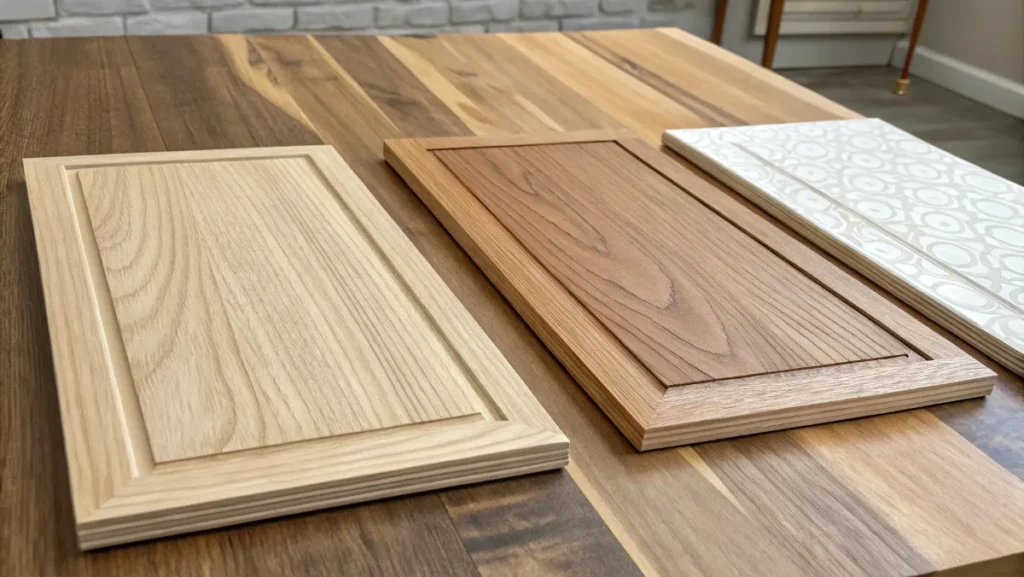
Let’s be honest: when you’re juggling a toddler who thinks cabinet doors are musical instruments, a husband who stores tools in the pantry, and a cat who thinks the countertops are his kingdom… not every cabinet material survives.
I’ve learned (the hard way) that beauty alone doesn’t cut it. Here’s how I break things down now, based on actual use, budget crunches, and the chaos level in my kitchen.
What I’d Use Again (Any Day)
-
Plywood for cabinet boxes is Affordable, sturdy, and surprisingly forgiving during installs. Still going strong under our sink, even after “the Great Soap Leak of 2023.
-
Solid wood for doors, Pricey, yes. But I swear, sanding and re-staining those maple fronts two years later gave me chef’s kiss results.
-
Painted MDF for uppers, Clean finish, budget-friendly, and great if you’re not steam-bombing them daily.
What I Use Strategically
-
Veneer, Gorgeous, but only on upper cabinets or low-contact zones. Not sink-adjacent.
-
Laminate, Great for rentals, laundry rooms, or guest spaces. Skip it near anything hot.
What I Lovingly Avoid Now
-
Thermofoil looks pretty… until the stove gets too close. Lesson learned.
-
Particleboard just no. Unless you like mystery swelling and corners that crumble like old biscotti.
My Go-To Combos
-
Budget build: Plywood base + MDF fronts (painted) + basic metal pulls = functional and cute for under $800.
-
Upgrade version: Plywood structure + solid wood doors + soft-close hinges = dreamy results with long-term value.
I don’t always get it right. I once tried to DIY particleboard panels into floating shelves (they bowed like a sad shelf emoji). But with every cabinet project, I’ve gotten better at pairing materials with how we live.
Because let’s face it: a cabinet that looks good in the showroom means nothing if it can’t survive spaghetti night, juice box ambushes, or a curious cat doing midnight laps on the counter.
What’s the best all-around cabinet combo for families?
For most busy homes: Plywood boxes with MDF or wood veneer doors. Durable enough to handle chaos, smooth enough to clean easily, and flexible enough to repaint or touch up later. Add soft-close hinges if you want to feel fancy.
FAQs About Cabinet Materials From Me and My Neighbors
I can’t tell you how many times my neighbor Sarah has texted me photos like, “Is this wood or fake wood?” Or how often Linda’s stood in my kitchen, pointing at cabinets and asking if they’ll hold up to her twin boys and their Nerf arsenal.
So I figured, why not round up the most common questions I get, and answer them like I would if we were chatting over coffee at my kitchen table (which, yes, is surrounded by at least three types of cabinet materials
What is the best material for built-in cabinets?
If you’re doing built-ins that need to last (think mudroom, pantry, or dining nook), I vote for plywood boxes with either MDF or solid wood doors. Plywood holds weight and resists warping. For a clean look, painted MDF doors can give you that high-end custom vibe, without needing a trust fund.
What is the cheapest material to build a cabinet?
Particleboard wins the price war, but it’s also the most fragile. MDF is a step up (still budget-friendly, but sturdier). If you’re okay doing a little finishing work yourself, you can make MDF look polished for less than $40 a panel. Just don’t expect it to survive a kitchen flood or a rogue spaghetti toss.
Is it cheaper to build your own cabinets or buy them?
Short answer: Yes, but only if you have time, tools, and patience.
I built our utility cabinets and saved about 40%, but also spent 12 hours learning how to install soft-close hinges correctly. (And yes, one still slams.) If you’re handy, DIY can save you cash. If not, buying ready-to-assemble might actually be the saner choice.
Closing Thoughts, and One Cabinet I’ll Always Love,
There’s this one cabinet in our kitchen, tucked under the window near the breakfast nook. I built it from scratch using leftover plywood, painted the door three times to get the right shade of sage green (the first two looked like toothpaste), and topped it with a $12 thrift-store handle. It’s where we keep the tea, the chocolate stash, and, somehow, every measuring spoon we own. And every time I open it, I remember that I can build things. Even if they’re not perfect. Especially if they’re not perfect.
That’s the thing about cabinet materials: it’s not just about strength, cost, or trends. It’s about choosing what fits your kitchen, your life, and all the messy, joyful chaos that comes with it.
Whether you’re sanding down old doors, buying your first MDF panels, or just Googling “what is melamine” while sipping coffee in your bathrobe (been there), you’re not alone. I’ve made the mistakes, figured out the fixes, and spilled paint on more than one pair of jeans to get here.
So whatever you choose, I hope it makes your kitchen feel a little more like you. A little cozier. A little more functional. A little more yours.
Let me know if you try any of these materials, especially if your cat knocks something over. I’ll be cheering you on, one cabinet at a time.

